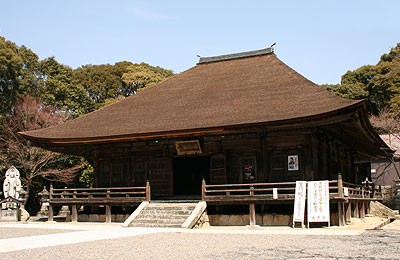|
||
 |
||

Takisanji Hondou êR{° (Aichi)
@
(C)2001 Japanese Architecture and Art Net Users System.@No reproduction or republication without written permission.
fÚÌeLXgEÊ^ECXgÈÇASÄÌRec̳f¡»E]ÚðֶܷB
|
||||||
| @ | ||||||
| hondou@{° | ||||||
| KEY WORD :@architecture / buildings & structures | ||||||
| @ | ||||||
| Lit. main hall. A Buddhist hall housing the principal images most revered by the particular sect of a temple. The use of the term hondou became prevalent after the rise of the new esoteric sects; Tendai Vä, and Shingon ^¾, in the 9c. The term hondou is thought to have originated from the desire to avoid the use of the word *kondou à°, which was, at the time, associated with the six sects, rokushuu Z@, that had flourished in Nara in 6c-8c. The hondou deviated from the plans of the kondou by establishing a less rigid arrangement. The interior became accessible to the devotee and a wore Japanese style was adopted. The natural timber buildings with cypress-bark shingled roofing *hiwadabuki Oç, had plank flooring either throughout the building or in the worship hall *gejin Ow, in the front area inside the building, which allowed people to pray sitting on the floor in Japanese fashion. Some sanctuaries had a hard packed earthen floor *doma yÔ, but others had plank flooring. The structure also had a hidden roof *noyane 쮪, which was first used over the aisles *hisashi ù, in Houryuuji *Daikoudou @²åu° (rebuilt 994) in Nara. By the end of the Heian period, many buildings besides the hondou had hidden-roof structures obscured by the installation of ceilings *tenjou Vä. Sliding lattice screens to separate the worship area from the sanctuary became universal in the hondou of esoteric temples. Examples: Taimadera Hondou (*Mandaradou Öä¶ °; 1161) in Nara ; Choujuji ·õ Hondou (13c) in Shiga prefecture ; Myoutuuji ¾Ê Hondou (1258) in Fukui prefecture ; Takisanji êR Hondou (14c) in Aichi prefecture ; Chikurinji |Ñ Hondou (1469-1487) in Kouchi prefecture ; Enryakuji ï *Konpon chuudou ª{° (1640) in Shiga prefecture, retained the doma style flooring and hard-packed earthen floor in the sacred area, and plank flooring in the worship space. | ||||||
| @ | ||||||
 Takisanji Hondou êR{° (Aichi)
|
||||||
@ |
||||||
| REFERENCES: | ||||||
| @ | ||||||
| EXTERNAL LINKS: | ||||||
| @@ | ||||||
| NOTES: | ||||||
| @ | ||||||
(C)2001 Japanese Architecture and Art Net Users System.@No reproduction or republication without written permission. fÚÌeLXgEÊ^ECXgÈÇASÄÌRec̳f¡»E]ÚðֶܷB |
||||||
| @ |